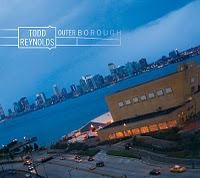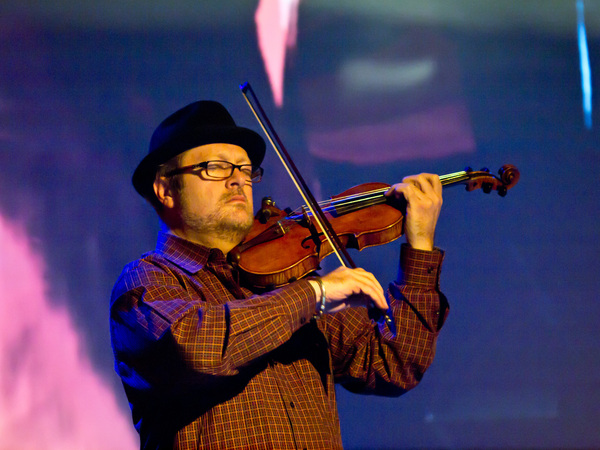 Todd Reynolds: Outerborough (Innova, 3/29/11)
Todd Reynolds: Outerborough (Innova, 3/29/11)
Todd Reynolds: “Transamerica”
[audio:https://alarm-magazine.com/wp-content/uploads/2011/03/Todd_Reynolds_Transamerica.mp3|titles=Todd Reynolds: “Transamerica”]
Violinist, composer, and producer Todd Reynolds has taken on an outsider, almost renegade role in music. Though he had a strict classical upbringing and a leading seat in an orchestra, Reynolds took his own path for a more personal means of expression, utilizing electronic loops and effects as a context for his dizzying improvisational instrumentation and emotive compositions.
His new double album, Outerborough, is an all-encompassing look at the myriad ways that the artist creates and collaborates, with one half of the album composed and performed entirely by Reynolds, and the other a disc of Reynolds performing pieces written by friends such as Nick Zammuto and Paul de Jong of The Books, Michael Gordon, David Lang, Phil Kline, and more. Speaking with Reynolds from his home studio, the virtuoso experimentalist shares his passion for music and explains why he choose the path that he did.
What was your musical upbringing?
Well, I’ve been playing the violin since the age of four. Around high school, I ended up studying with the late, great violinist Jascha Heifetz, one of the most famous concert violinists who ever lived. I then went to music school back in Rochester, joined the Rochester Philharmonic, and was principle second violin. I then moved back to New York, went back to school, and began my career.
When did you start exploring electronics as part of your compositions?
Even from my earliest days of college, I was interested in the outside aspects and the avant-garde side of music. So I was pretty heavily invested in that music. But I started using electronics shortly after I left the orchestra. I went back to school to get a master’s degree, and it was in that time that I went in that direction.
How did that change things for you?
Well, a lot of my electronic exploration was in the service of learning how to improvise. When I write music, I always leave a lot of space for myself to be able to make something up on the spot. So I began with long reverbs and digital delays and just creating things that I could hear back and then play to. That was some of the early stuff. I was not so interested in drum machines or synthesizers at all.
I became a looper, for lack of a better term. It became all about signal processing. And I still do a lot of processing, but now I use drum loops and so on, and the whole process evolved to point where I produced this double CD all in my studio at home. Sound production became my way of composition, my compositional tool. Much like Brian Eno, the studio is my collection of instruments and my collection of processes to make music.
What was the inspiration for your new album?
My whole career has been about the two sides of me: the side that plays other people’s music and then my whole compositional and improvisational evolution. So one side is organized with my music, and the other side is organized with music that was written for me. And those people who I asked to write for me are long standing collaborators, so they know what I do.
Can you speak more on those differences in the two sides?
Classical people grow up playing everybody else’s music, right? So I’ve been playing other people’s compositions forever. What changed for me in college was that I realized I wanted to play people’s music who were alive, not dead! So it became very important to me to play things that were really current and not too old. The difference is that when I’m playing other people’s music, I’m playing it with a mind to make it my own and getting inside of it as much as I can. When I’m playing my own music, I don’t have to get inside of it at all because it’s coming from the inside of me — which is sort of why the two CDs are each named “InSide” and “OutSide.”
This album was reportedly five years in the making. Can you talk about why, or how, that affected the outcome?
A lot of it has to do with how much I have to actually work to make a living, constantly touring and playing for people. Also, since I’m doing all of the work myself and have no real partnership in terms of production, I’m sort of obsessing over every little detail.
Do you consider yourself a perfectionist?
Well, I have a real problem with that word. I don’t believe in the concept of perfection. But I will say that I don’t let things go easily. I’m a person who wants to play with something until it feels exactly what I want it to feel like. But it isn’t so much about the details of having every note be perfect; it’s more that I want the feeling to be perfect. I want to make sure that when I put it out to an audience that it has the greatest chance of communicating what I want it to communicate.
So I’d rather take a long time and really let something develop, like all of these pieces. These are pieces that developed and changed over time. And because the production part of it is partly my instrument — it’s not just the violin — I would try things out and then come back to it months later, and think, “You know, I’d really like to hear this now.”
And how does your tendency for improvisation play with this?
What I’m leaving room for is so that when I play live, parts can change or I can loop, more or less. So yes, all the pieces have room so that they’re fresh every time I play them. And the reason that I want that is twofold. One, I want every audience to hear something special, and I also want to keep my own attitude fresh and not get into a routine.
How critical for you is it to be able to compose and write regularly, rather than just playing?
Absolutely critical. It’s completely important for me to be improvising all the time, to be playing for people all the time, and to be composing. So all those things in different variations and recipes, that has to be happening for me all the time cause that’s the lifeblood of who I am.
I grew up as a violinist, you know. I was destined to be a concert violinist playing in front of an orchestra. That’s what my parents wanted for me, but I realized that what I was looking for was a vehicle for self-expression that couldn’t just be confined to the violin, couldn’t be confined to playing other people’s music. What I found that worked for me was this combination of ways of making music, and also collaborating. It’s vital for me to be collaborating with people. So some combination of that is what keeps me going in this world.
[Have you pre-ordered yet? Don’t miss our limited-time offer, saving up to 38%, for Chromatic: The Crossroads of Color and Music, our next book that profiles independent musicians and artists who explore color in unorthodox ways.]

